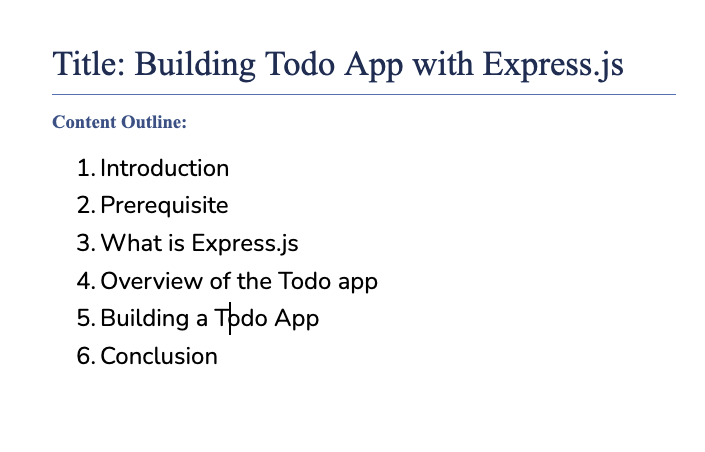Defining a technical writing process is subjective and it depends on the type of content and the technical writer. It is basically a process you follow to produce high-quality technical content.
This article is part of our Technical Writing Series, you can read the previous series before you jump to this one.
- What is Technical Writing?: We explored technical writing in-depth and get you started creating your first technical content.
- Who is a Technical Writer?: We explore who a technical writer is, the different types of technical writers, and the different skillset required to become a technical writer.
- Types of Technical Writing: We broke down technical writing into 3 broad types and discuss in detail these different types and how to choose a specific category.
- Technical Writing Niches: We explored the different technical writing niches or types of technical content you can specialize in as a technical writer and produce 1 deposit casino uk.com.
- The Technical Writing Process: We will explore the lean technical writing process that will help you create high-quality technical content consistently.
- How to Become a Good Technical Writer? We discussed the factors you need to make you stand out and become a good technical writer.
In this series, we will explore the lean technical writing process that will help you create high-quality technical content consistently.
The Technical Writing Process
We will look at a lean technical writing process originally created by Linda Ikechukwu from Everythingtechnicalwriting. This process is very simple and covers everything you need to produce steady high-quality technical content.
However, we will modify the process to follow our standard way of generating high-quality content each time.
The lean process is divided into the following:
- Define your audience
- Define the goal of the content
- Define the goal of the content
- Define your content brief
- Write an outline
- Do your research
- Write the first draft
- Rewrite the first draft
- Ask for feedback
- Fine-tune and polish
Define your audience
When you have a technical content idea or proposed topic to work on. The first thing you need is to research the audience that intends to consume your technical content.
This knowledge lays a clear path for you to determine the tone, voice, and tenses of the technical content.
It is more impressive to write for a specific target audience than to try to cover everyone. This makes your technical content more impactful and useful to that unique audience.
Here are some of the questions you need to ask yourself when determining the specific audience you’re targeting.
- Who am I writing this piece of content for?
- Are they beginners, advanced, experts, etc?
- What is their profession(Developers, designers, etc)
- What knowledge is required before reading this technical content?
coco sneakers
Jordan 4
Replica Shoes
Cocokick
Rep Balenciaga Track
Cocoshoes
Reps Shoes
Reps Shoes
Air jordan
Rep Shoes
cocosneakers
Coco Shoes
Coco Shoes
Coco Shoes
Coco Shoes
Coco Shoes
Coco Shoes
Coco Shoes
Coco Shoes
Coco Shoes
Cocoshoes
Rep Shoes
Coco kicks
Cocoshoes
Rep Shoes
Replica Balenciaga
Balenciaga Reps
reps jordan
Rep Shoes
Bathing Ape
There are more questions, but these will help guide you towards developing a reader’s personal for your technical content.
Define the goal of the content
The next important factor is to determine the goal of your technical content before you even start writing. This helps you stay on track instead of straying away from the main goal of the technical content.
The most important factor of every technical content you produce is to provide value. The value you want to provide in the technical content will determine how you structure the content.
For instance, if you want to create technical content that shows a reader how to build X product with Y technology.
From the goal, you will understand that you will show code samples, show step by step guide with the knowledge gotten from determining the goal of your technical content, and your content will be structured or presented in a way that delivers the value appropriately.
To determine the goal of your technical content, you can ask yourself these questions:
- What will the reader achieve from reading the content?
- What value will my readers gain from this technical content?
- What problem will my readers be able to solve after reading this technical content?
Above all, you need to determine what your readers expect or what they will benefit from reading your technical content.
Define your content brief
Content briefs are very important to give you context for the type of technical content you are creating.
A content brief is a summary of what the content is supposed to achieve, the audience definition, the primary and secondary keywords, the goal of the technical content, competitors’ content to draw insights, etc.
This document is the result of the above research for defining your audience and defining the goal of the technical content.
However, companies give writers this document to give the writers context as to what the company wants the technical content to cover.
Nevertheless, writers create their content brief to help them stay focused or to show the company what they intend to cover in the article.
*For each technical content we create, we must define a content brief to highlight the above before proceeding to create the content.*
Write an outline
A content outline gives a clear direction of what the final content will look like. It is like a map that guides you to a destination.
As a technical writer, it’s important you invest a little time in developing a great content outline for your technical content.
Personally, I use this approach to produce high-quality technical content faster.
To produce a great template for your content outline, you need to follow this approach.
Every content outline should contain the following:
- Content Outline Points
- Content Outline sub-points
Content Outline Points
From the title of your technical content and the information you have gathered from the research and content brief, you should be able to split the content into main sections.
For instance, if you’re writing the title: “Building Todo App with Express.js”
From your research, you will understand that the content is for complete beginners and you need to lay a foundation of knowledge before proceeding to the actual coding of the Todo app.
So you might want to define them in this format:

This lays out the main points you intend to cover in your technical content. next, to give more context to the main points, you can create a subheading to further simplify the points you intend to cover in the main heading.
Content Outline sub-points
This contains different sub-points you intend to cover from each main point listed above. Let’s take a look at the sample we are using.

The example above gives you a clear picture of what the final content will contain. Structuring your content outline this way also helps you easily get back to the content idea if you left it for a while.
Do your research
This is where the work starts, now you have a clear understanding of the technical content you want to produce. The next step is to jump into intensive research about the technologies involve and how you intend to pass the value.
Research is a very important factor for every high-quality content. That’s why every great content is split into 60% research, 10% writing, 10% editing, and 20% distribution.
Research is also a continuous process and it started right from when you define the audience, the goal of the content, and come up with your content brief.
Here is how you can start researching, if your content brief contains links to your competitor’s content on the same topic, start from there
Additionally, you can research through the top-ranking technical content on the same topic from any search engine of choice.
After researching, studying, and understanding the technologies and gaining authority over the topic.
Next, you write down the following points:
- What is missing in the articles you researched.
- What interest you the most.
- Check the comment section for what readers are saying.
- How do they structure the content?
- What can you improve in the article?
- If coding is required, do it now to gain more insight.
- Group your research results accordingly.
- etc
With this, you have enough authority and are also ready to come up with your first draft of the content.
Write the first draft
Writing your first draft should not be that hard because, from your research, you already have enough knowledge, authority, and idea of what to write.
Also, your first draft is more of a brain dump. It’s where you simply put down your ideas into writing without much consideration of grammar, structuring, etc.
Write down all the ideas related to the outline you have created for your content. If you get stuck at this stage, it’s normal, you can pause and do more research and come back to it.
The goal here should be to get your ideas into writing as quickly as possible without considering grammar, structuring, etc.
Rewrite the first draft
Rewriting your first draft is aimed to organize your technical content in an acceptable or presentable format.
Here, you check the structure of the technical content and make sure it passes the value intended in the content brief, and at the same time, the tones, voices, and tenses align with the audience you define for your technical content.
It is recommended to include additional resources for your readers after reading your technical content. This is where you should take it further by including additional resources for your readers from the research you conducted.
These are some of the things you need to check when rewriting your first draft.
- Most importantly, you need to make sure your content is readable by rewriting each paragraph to align with your audience if necessary.
- Remove fluffs or paragraphs that deviate from your main point and stick to giving value in each paragraph.
- Make sure to drive the reader through each section with your closing remark on each section.
There are many things to do at this stage, but most importantly, your technical content should pass the desired value to the intended audience at this stage before you move to fine-tuning your content.
Fine-tune and polish
At this stage, you need to fine-tune your technical content to give direct value without too many paragraphs, ambitious sentences, grammar, etc.
Here are some of the generic checklists of things you can do to improve your technical content.
- Run content through Grammarly for incorrect spellings and grammar
- Create smooth transitions between paragraphs, sentences, and sections.
- Run plagiarism check on your technical content using Grammarly or Unicheck
- Break bigger paragraphs into a max of 4 lines.
- Remove awkward phrases or ambiguous words to promote understanding and readability.
- Make your headers brief and promote value.
- Break out sentences with more than 3 conjunctions.
- Check all links for broken links.
- Check your conclusion to make sure it summarizes the content value.
There is every chance that after all these, your technical content is still not in good shape. At this point, you need to ask for feedback from your peers or editor.
If you’re a freelance technical writer, you can submit your first draft now and wait for feedback if you can’t get an editor or any peer.
Ask for feedback
Asking for feedback is a great way to learn and grow in the field of writing and the same is applicable to technical writing.
To become a great writer, you need a great editor that gives you constructive criticism and also helps you align your content to the right tone, voice, style guide, etc.
If you have a friend or an editor, this is the stage to get in touch with them for a second or third eye view of your technical content.
Discuss the feedback they provide to learn and improve them to improve the technical content before publishing.
The folks at Contentre are open to giving you constructive feedback on your technical content anytime. You can join our community to grow your technical writing career.
Publish and share
Content publishing and distribution is a broad topic as it covers 20% of your content journey.
If you’re a freelance technical writer, write the technical content for a company. The company will handle the publishing and maybe give you the link to your published content for your social platform promotion.
Also, if you write for yourself, this is the time to publish your content and share it with the world.
Whichever, Contentre gives you a publishing tool that helps you auto-cross post your technical content on platforms such as Medium, Hashnode, Devto, WordPress, Strapi, and other CMS at once.
The tool also allows you to auto-share your content on your connected social media accounts.
You should definitely check it out for your technical content publishing and social media promotion.
Summary
Producing high-quality technical content takes time and it’s also very rewarding in the end because it makes you stand out from the crowd and be the point of contact for high-paying clients and companies.
We have listed and discussed the lean technical writing process to enable you to produce high-quality technical content and grow your technical writing career.
Let us know your thoughts in the comment section.
Contentre helps technical writers stay organized and gain more clients. Grow your technical writing career in one place.
Now that you’re here, let me briefly recap the most important features Contentre can offer you:
- Organize your content in categories, topics, and tags
- Create and manage multiple clients
- Create and manage multiple personalized portfolios
- Get statistical analytics of your content revenue, top categories, and tags.








5 Comments
Pingback: Top 14 Profitable Technical Writing Niches (2022): Choosing one - Contentre Blog
Pingback: Who is a Technical Writer? How to become one (2022) - Contentre Blog
Pingback: What is Technical Writing? The Complete Guide (2022) - Contentre Blog
Pingback: Technical Tutorials: How to Write Good Technical Tutorials (2022) - Contentre Blog
Pingback: Types of Technical Writing: How to Choose? (2023) - Contentre Blog